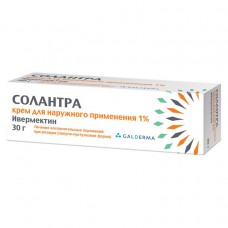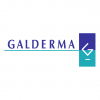Expiration date: 01/2026
Pharmaceutical form Cream white to light yellow in color.
The composition of 1 g of cream contains:
Active substance: ivermectin 10, 0 mg.
Excipients: glycerol 40, 0 mg, isopropyl palmitate 40, 0 mg, carbomer copolymer type b 2, 0 mg, Dimethicone 20 Cst 5, 0 mg, disodium edetate 0, 5 mg, citric acid monohydrate 0, 5 mg, cetyl alcohol 35, 0 mg, stearic alcohol 25, 0 mg, macrogol cetostealer ether 30, 0 mg, sorbitane stearate 20, 0 mg, methylparahydroxybenzoate 2, 0 mg, propylparahydroxybenzoate 1, 0 Mg, Phenoxyethanol 10, 0 Mg, propylene glycol 20, 0 mg, oleyl alcohol 20, 0 mg, sodium hydroxide solution 10% to pH 6, 3±0, 3, purified water up to 1000 mg.
Pharmacological action
Ivermectin belongs to the group of avermectin, which has an anti-inflammatory effect by suppressing the production of inflammatory cytokines induced by lipopolysaccharides. Anti-inflammatory properties of ivermectin for external use were observed in models of inflammatory skin processes in animals. Ivermectin also causes the death of parasites, mainly through selective binding and high affinity for glutamate-regulated chlorine channels found in the nerve and muscle cells of invertebrates. The mechanism of action of the drug Solantra in the treatment of inflammatory skin lesions in rosacea is not known, but may be associated with both the anti-inflammatory effects of ivermectin and the ability of ivermectin to cause the death of Demodex mites, which, in turn, are a factor that causes skin inflammation.
Pharmacokinetics
Suction
Absorption of ivermectin contained in Solantra was evaluated in a clinical study involving adult patients with severe papulo-pustular rosacea who used the maximum allowable dose of the drug. In the equilibrium state (after 2 weeks of treatment), the highest average (± standard deviation) plasma concentrations of ivermectin were observed within 10 ± 8 hours after administration of the drug (Cmax: 2, 1 ± 1, 0 ng/ml, range: 0, 7-4, 0 ng/ml), and the highest average (± standard deviation) AUC0-24 h was 36 ± 16 ng h/ml, range: 14-75 NGH/ml). Systemic exposure to ivermectin reached a plateau by the end of the second week of treatment in an equilibrium state. With longer treatment in phase 3 studies, the indicator of systemic exposure to ivermectin remained the same as after two weeks of treatment. At equilibrium concentrations, the levels of systemic exposure of ivermectin (AUC0-24 h: 36 ± 16 ng h / ml) were lower than after a single oral administration of 6 mg ivermectin in healthy volunteers (AUC0-24 h:134 ± 66 ng h/ml).
Distribution
An in vitro study showed that binding of ivermectin to plasma proteins (mainly albumin) is more than 99%. Significant binding of ivermectin to red blood cells was not observed. Metabolism in vitro studies using human liver microsomes and recombinant CYP450 enzymes, it has been observed that ivermectin is primarily metabolized by CYP3 A4 inhibitors. In vitro studies have shown that ivermectin does not inhibit CYP450 isoenzymes 1A2, 2A6, 2B6, 2C8, 2C9, 2C19, 2D6, 3A4, 4A11 or 2E1. Ivermectin does not induce the expression of CYP450 enzymes (1A2, 2B6, 2C9 or 3A4) in human hepatocyte culture. 2 main metabolites of ivermectin (3” - O-demethyl ivermectin and 4A-hydroxy ivermectin) were identified during a clinical pharmacokinetics study using the maximum allowable dose of the drug and studied during phase 2 clinical studies. Similar to the original compound, the metabolites reached an equilibrium state by the end of the second week of treatment, no signs of accumulation were observed in the period up to 12 weeks. In addition, systemic exposures of metabolites (estimated using Cmax and AUC)obtained at equilibrium were much lower than those after ingestion of ivermectin.
Breeding
The final half-life, on average, was 6 days (approximately 145 hours, range: 92-238 hours) in patients who applied the drug to the skin once a day for 28 days during a clinical pharmacokinetics study using the maximum allowable dose of the drug. Elimination from the body depends on the degree of absorption after external application of Solantra cream. The pharmacokinetics of ivermectin has not been studied in patients with impaired liver and kidney function.
Side effect
The most frequent adverse reactions, such as burning sensation, skin irritation, itching and dry skin were observed in less than 1% of patients treated with the drug during clinical trials. As a rule, these reactions are mild or moderate in nature and usually weaken with continued therapy. There were no significant differences in the safety profile in patients aged 18 to 65 years and patients aged over 65 years. Skin irritation, itching, dry skin, Contact dermatitis, allergic reactions


